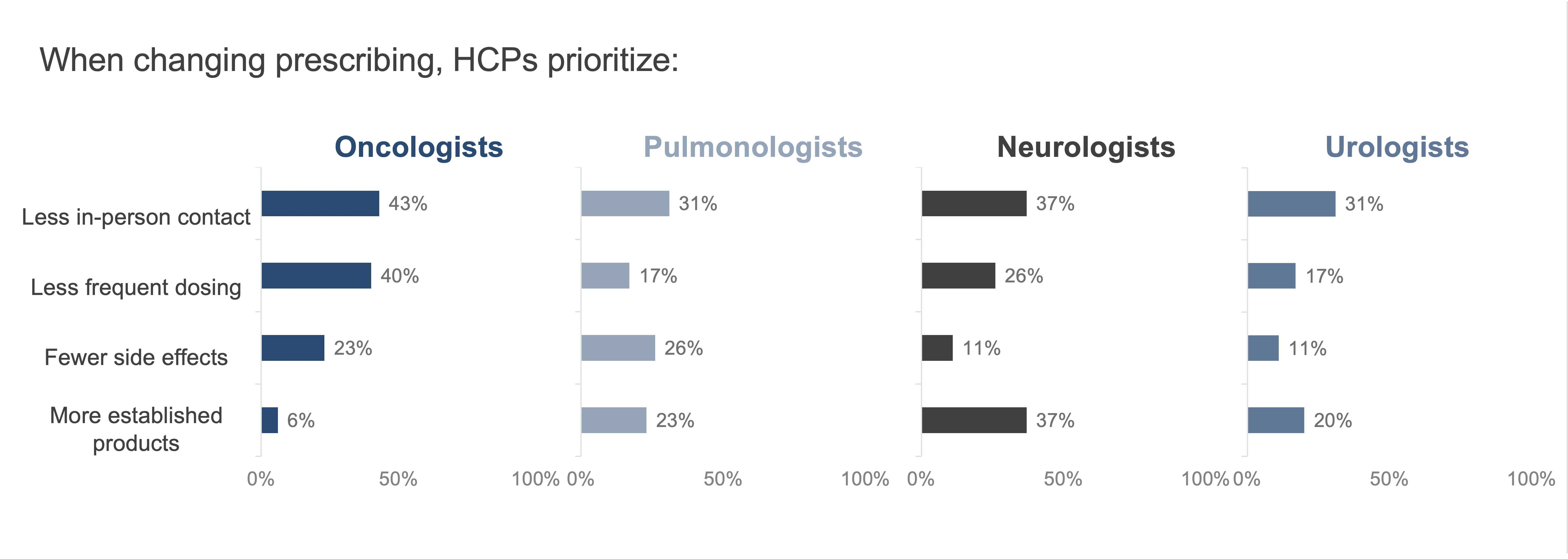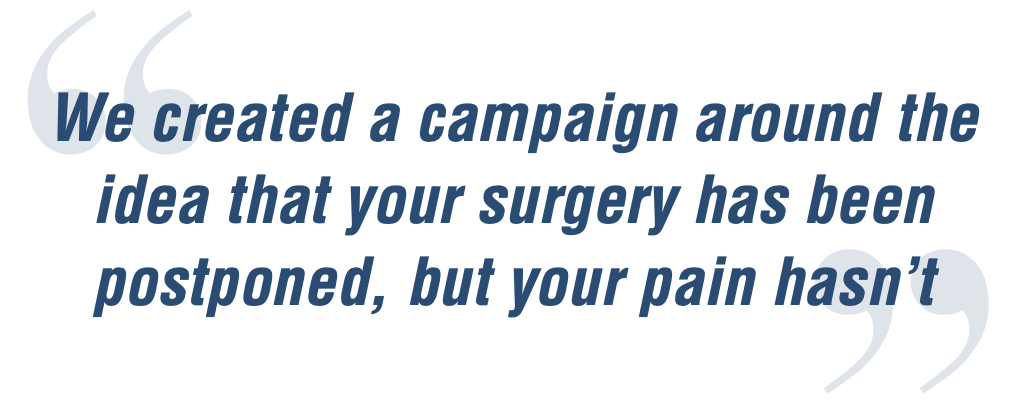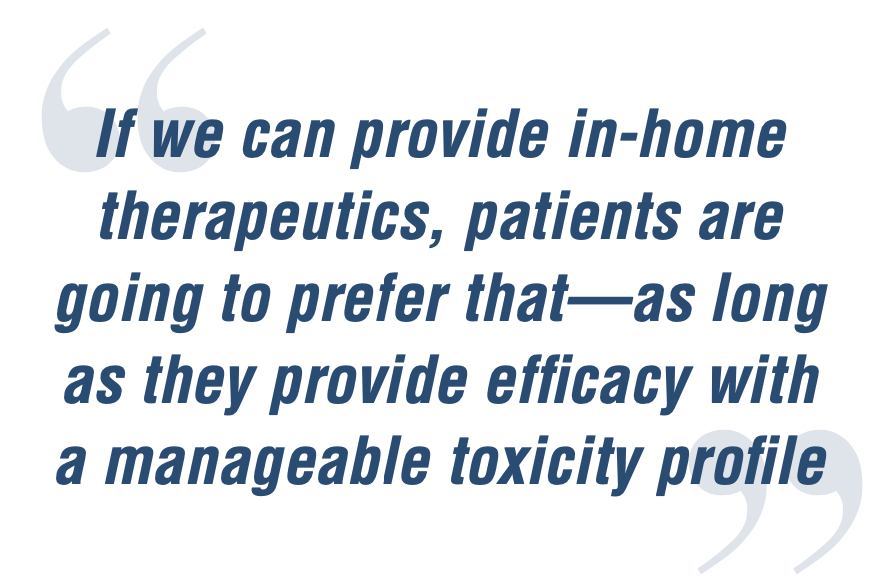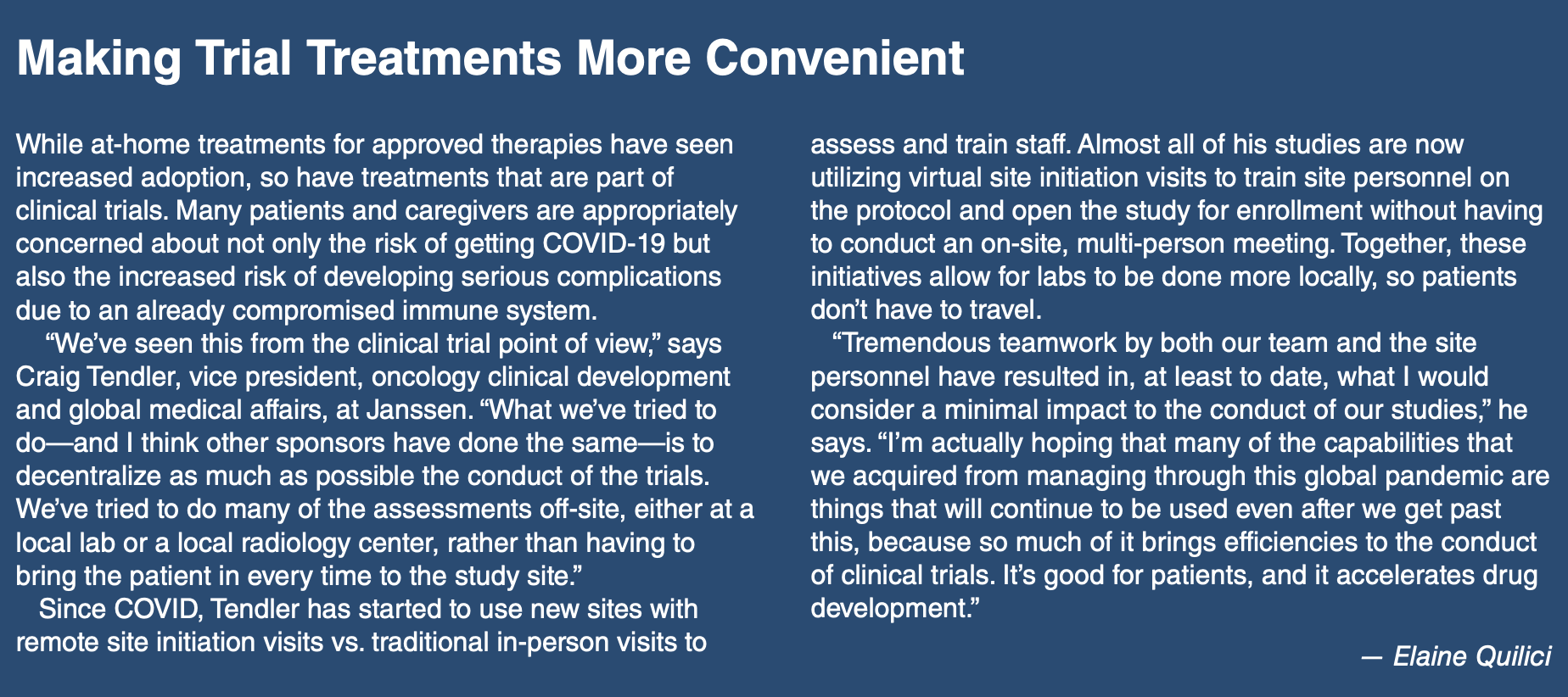Assessing the Unexpected: The Unintended Consequences of COVID on Therapeutics
How the pandemic’s impact on physicians and patients has spurred fundamental changes and redefined approaches in areas such as adherence and drug formulation and delivery.
According to the Commonwealth Fund, the number of visits to ambulatory practices declined nearly 60% by early April. Though a rebound was felt by mid-May, the number of visits was still about one-third lower than what was seen before the COVID-19 pandemic. While this statistic negatively impacted many patients medically and physicians economically, there was a silver lining. The need for more convenient formulations of pharmaceuticals began to grow. Now that patients and physicians have more freely adapted these alternative therapeutics, it could portend a future interest in how pharma develops product.
A shift in care
If COVID itself didn’t shutter physicians’ offices, most doctors experienced a decline in patient visits. People expressed their reservations about attending in-office visits by postponing or canceling everything from routine and follow-up visits to elective surgeries and necessary procedures. Many people felt safer putting off treatments while others felt they might be doing society a favor by not overloading an already taxed health system. For whatever reasons, when patients did have to see a doctor, they tried to minimize their time in offices, clinics, and hospitals.
Kristen Backor

As a response to this, physicians also had to change. Charles River Associates (CRA) recently reported that more than half (61%) of healthcare providers (HCPs) have changed their prescribing decisions in some way as a result of the coronavirus (see Figure 1 on below). This included 77% of oncologists, 54% of pulmonologists, 65% of neurologists, and 46% of urologists. The study also looked at how COVID altered prescribing decisions (see Figure 2 further below) and revealed that 43% of oncologists, 31% of pulmonologists, 37% of neurologists, and 31% of urologists said they were more likely to prescribe options with less in-person contact (e.g., subcutaneous or oral administrations vs. infusions).
“These data reflect changes in physician management as a result of the COVID-19 pandemic, and these changes are likely to have an impact into 2021 and beyond,” says Kristen Backor, study author and director of market research at CRA. “These findings have implications for marketing and forecasting for both products currently on the market and those expected to launch within the next few years.”
Figure 1. Over 75% of oncologists have altered their Rx decisions during the pandemic. Source: Charles River Associates (click to enlarge)

Figure 2. Oncologists are more likely to prescribe options with less in-person contact (e.g., subcutaneous or oral administrations vs. infusions). Source: Charles River Associates (click to enlarge)

Oncology leads the way
As indicated in the CRA study, oncologists have been at the forefront of redefining care. Many therapeutic treatments in this space traditionally have been administered via IV infusion and subcutaneous injection, making it an area ripe for reinvention amid the pandemic.
In April, the National Comprehensive Cancer Network’s Best Practices Committee announced strategies to mitigate the transmission of COVID among cancer patients and practitioners. It encouraged changing therapies to oral medications whenever possible.
Murray Aitken

Data from IQVIA also show a trend in this direction. They indicate that the use of IV-administered oncology therapies was 6% lower than expected in 2020 through October, while those self-administered were just 2% lower (see Figure 3 below). “It’s pretty clear there has been a shift,” says Murray Aitken, executive director at IQVIA and Pharmaceutical Executive editorial advisory board member. “It’s probably not as much as people think, but it makes sense, particularly with the close-down of hospitals and the diversion of patients.”
“This is a group of patients, unfortunately, that’s compromised—highly compromised, in some cases—with their immune system, especially later-stage patients,” says Tim Cook, senior vice president of global oncology at Athenex. “If there’s a group that we want to protect and minimize risk, this is the group.”
Figure 3. Source: IQVIA National Sales Weekly, 10/9/2020 (click to enlarge)

Athenex’s lead molecule, oral paclitaxel and encequidar, is the first oral taxane in late-stage clinical development with a first planned indication in metastatic breast cancer (MBC). Encequidar is the cornerstone of the company’s deep pipeline of oral chemotherapies.
Cook says his company is approaching treatment from three different directions. On the front end, there is the treatment decision. At that point, there will be an oncology nurse educator team in place to inform the healthcare team—the physician, nurse, and pharmacist—about available resources and how to dose appropriately. This includes a patient support hub and patient education materials. Then, at the time of access, either Athenex’s network of specialty pharmacies or its patient support hub will work with patients. On the back end, the call center will continue to reach out to patients as desired, based on their preferences.
“I think there will continue to be a push for therapeutics that can be taken within the home and followed up with the physician as needed,” says Cook. “Pandemic aside, we do believe that giving more options to patients with cancer is absolutely critical.”
Therapies that reduce in-office time are also in demand. At Janssen, Darzalex, a drug approved for multiple myeloma that has been on the market for several years in an IV formulation, received approval in May for a subcutaneous formulation. The infusion time went from seven hours for the initial infusion to about three to five minutes.
Craig Tendler

“We’ve seen a huge uptake over the last two or three months, much greater than we would have anticipated, of the subcutaneous formulation,” says Craig Tendler, vice president, oncology clinical development and global medical affairs, at Janssen. “Physicians, practices, and clinics need to be educated about that new administration schedule and that has been adopted almost instantaneously. The vast majority of the utilization over the last two or three months has been converted now to the subcutaneous administration for Darzalex.”
Though the company has already provided an enhanced option for delivering Darzalex with respect to reducing the risk of infusion-related reactions and the amount of in-office chair time, it may eventually be possible to transition the subcutaneous treatment to a home administration, which would eliminate an office visit altogether.
Benefits of convenience
Raj Kannan

“During the COVID-19 pandemic, over 60% of patients participating in a market research survey reported that they would prefer not to use medically administered products requiring them to travel to the doctor’s office for treatment,” says Raj Kannan, CEO of Chiasma, the manufacturer of MYCAPSSA, the first and only FDA-approved oral somatostatin analog therapy indicated for the maintenance treatment of patients with acromegaly. “Given the desire for people to limit potential exposure to COVID-19 by social distancing, at-home therapies are becoming increasingly important.”
To help patients with the transition, Chiasma has a patient support program to help guide them through treatment and ensure they have the support they need.
“It’s incumbent upon the companies to make sure they’re providing a comprehensive set of resources for the patient and the caregiver that assists them in ensuring that they’re taking the drugs appropriately,” says Cook. Athenex plans to have a support center where they can enroll and have a nurse reach out to them on a regular basis to coach and support them.
Though COVID may have necessitated convenient treatments, a post-pandemic world will likely continue their popularity. Now that people have broken the barrier and grown their experience with these alternative products, they can better understand their value.
Among the benefits patients can realize moving forward:
- Increased freedom. In oncology, weekly infusions are often required. The time commitment of patients and their caregivers can sometimes be half a day or more. Oral options in lieu of office visits or subcutaneous administrations that reduce in-office presence could free up a good amount of time, giving patients and caregivers greater freedom of life.
- Less use of pre-meds. Though it depends on the particular IV, some oncology treatments require pre-medication, which could cause anaphylactic or hypersensitivity reactions. Oral therapies don’t deliver a high dose at one time, so pre-meds, like steroids, can often be eliminated.
- No injection reactions. Patients with acromegaly report significant burdens associated with the current standard of care, which often includes monthly injections by a trained professional in a healthcare setting. These can cause site reactions and pain that lingers for days. Oral treatments avoid this.
- Increased compliance. Easy, convenient administration can enhance compliance and adherence to regimens, which in turn can improve treatment outcomes.
Dealing with delays
As people put off surgeries during COVID, an unfortunate therapeutic consequence has been a reliance on opioids to deal with the pain they’re experiencing. As the IQVIA Institute conducts its annual prescription opioid review—which has been extended beyond the end of 2019 to include what happened during COVID—researchers have noticed little decrease of opioids prescribed by orthopedists, even though elective surgeries are down.
“We’re tracking the elective procedures, and people stopped having hip surgeries and knee surgeries,” says Aitken. “But we know that some of those people are in pain. Therefore, the consequence was greater use of opioids.”
This surge has also been seen in a non-opioid way to deal with to pain. Flexion Therapeutics’ Zilretta, an injection for the treatment of osteoarthritis knee pain, recorded a slight dip in demand when the pandemic first hit, but soon it increased sharply and led to significant month-over-month growth, which included new orthopedics practices purchasing Zilretta for the first time. Whether it was due to patients’ fear of contagion that kept them out of facilities or concerns about missing work in light of economic uncertainties, the climate caused a marked increase in demand for the drug.
Contrary to common immediate-release injectable steroids, which flood the joint and provide pain relief that lasts for weeks, Zilretta offers a slow-release steroid that lasts for at least three months. Because steroids can interfere with insulin action, a slow-release vs. immediate-release injection also can help prevent a spike in blood sugar for diabetic patients.
Michael Clayman

“We created a campaign around the idea that your surgery has been postponed, but your pain hasn’t, and Zilretta could be a bridge until you may be able to have surgery,” says Michael Clayman, MD, president and CEO of Flexion Therapeutics. “We think that contributed to the strength in numbers. In the second quarter, the consensus estimates for Zilretta were $10.5 million. We did 50% better than that, $15.5 million. For Q3, we announced sales of $23.6 million, which substantially exceeded the consensus estimates of $20.5 million.”

Beyond COVID, the company sees the market for Zilretta may be driven by younger sufferers looking to avoid joint replacements, which typically last 15 to 20 years.
“COVID has really created an opportunity,” says Clayman. “It has opened a door for physicians and patients to gain experience with Zilretta in a way that might not have happened in the time frame that it did. In our experience, once a physician has treated 10 or 20 patients with Zilretta, you get a feedback loop of data which indicates this product is pretty special. That’s reinforcing and it allows the potential to accelerate the adoption curve.”
Getting the word out
Despite increased interest in more convenient treatments, educating patients and physicians about them has seen some challenges amid COVID. Much of the information about therapies is usually shared by doctors and nurses in the office. The rise of telemedicine has made it more difficult for patients to access these materials now.
This shift in treatment has required companies to refocus their education efforts. For instance, Athenex is investing in patient education with both the physician and DTC, but it is stressing the importance of clinical teams right now.
Tim Cook

“Our research shows that by and large it’s the physician that’s making the decision, consulting with the patient, laying out the choices,” says Cook. “It’s driving awareness with the clinical community that is going to be really important, because if they don’t believe in the drug, then they’re going to educate the patient on why that’s probably not the best. It really starts with that clinical team in the treatment decision.”
Chiasma sales reps are currently working to disseminate pertinent data to help HCPs make decisions for their patients. “We hope that through continued education and advocacy efforts, patients with acromegaly and their healthcare providers will understand the safety, efficacy, and benefits of MYCAPSSA,” says Kannan.
Flexion is also targeting both settings extensively. Since Zilretta is a buy-and-bill product—which means the practice purchases the product and gets reimbursed after it uses it and submits to insurance—the company is motivated to prioritize communication with providers. It currently has more than 100 sales reps working with physicians. Though COVID shut the doors to many offices, this left doctors with more time to interact and engage. Reps had to transition from in-office visits to Zoom video discussions and telephone calls, but the communications shift was smooth. Reps continue to handle communications this way, except in areas that have opened up.
“You absolutely need to gain the clinical advocacy of the treating physician,” says Clayman. “But it doesn’t stop there. You have to be talking with office staff, procurement people, reimbursement people, to ensure that the process of reimbursement is seamless. We’ve taken that very seriously from the beginning.”
The company also believes Zilretta has the potential to be a word-of-mouth product. From the simple sharing of information through everyday conversation to the power of social media, positive experiences can parlay into expanded usage.
“As people get older, you spend a lot of time talking with your friends about aches and pains and your health status,” says Clayman. “When someone gets an injection of Zilretta and has a really good response, you can be essentially certain that that’s a topic of discussion with friends.”
Lasting impressions
It’s clear more convenient treatments rose to the surface during COVID, but it will be interesting to watch if this trend continues in R&D. Chiasma, for example, says it is exploring how to use MYCAPSSA in expanded patient populations and utilize its oral delivery technology to develop completely new oral treatments for patients who could also benefit from the transition from injectables to less burdensome oral options.
“In terms of COVID-19 highlighting opportunities for patients to receive medicines in more convenient ways, this might be a turning point,” says Aitken. “As telemedicine has reached some sort of an inflection point—I’m not quite sure we know exactly where it’s going to settle in at, but it’s not going to be where it was—I think the same can be said about alternative formulations of medicines.”

One cue might come from regulatory bodies. In July, FDA approved Inqovi tablets for the treatment of myelodysplastic syndromes (MDS), a condition usually treated via IV therapy. As part of the announcement, Richard Pazdur, MD, director of FDA’s Oncology Center of Excellence, stated that the agency was committed to providing new treatments for patients during the pandemic, in this case, an oral outpatient therapy that would reduce visits to healthcare centers.
He added, “At this critical time, we continue to focus on providing options to patients with cancer, including regimens that can be taken at home.”
“That’s a pretty strong signal that this isn’t going to go away,” says Cook. “If we can provide in-home therapeutics, patients are going to prefer that. Again, as long as they provide efficacy with a manageable toxicity profile, I think patients would prefer that, and the agency is recognizing that as well. I believe there will continue to be a strong desire, where possible, to provide not only oral but injectable [therapies], things that can be taken at home.”
Click to enlarge

Elaine Quilici is Pharm Exec’s Senior Editor. She can be reached at equilici@mjhlifesciences.com.

Regeneron, Roche Launch Major US Expansion Plans to Meet Growing Demand for Biologics and Innovation
April 22nd 2025With combined investments exceeding $53 billion, both companies are deepening their US presence through expanded biologics production, gene therapy capabilities, and next generation R&D centers.
Cell and Gene Therapy Check-in 2024
January 18th 2024Fran Gregory, VP of Emerging Therapies, Cardinal Health discusses her career, how both CAR-T therapies and personalization have been gaining momentum and what kind of progress we expect to see from them, some of the biggest hurdles facing their section of the industry, the importance of patient advocacy and so much more.